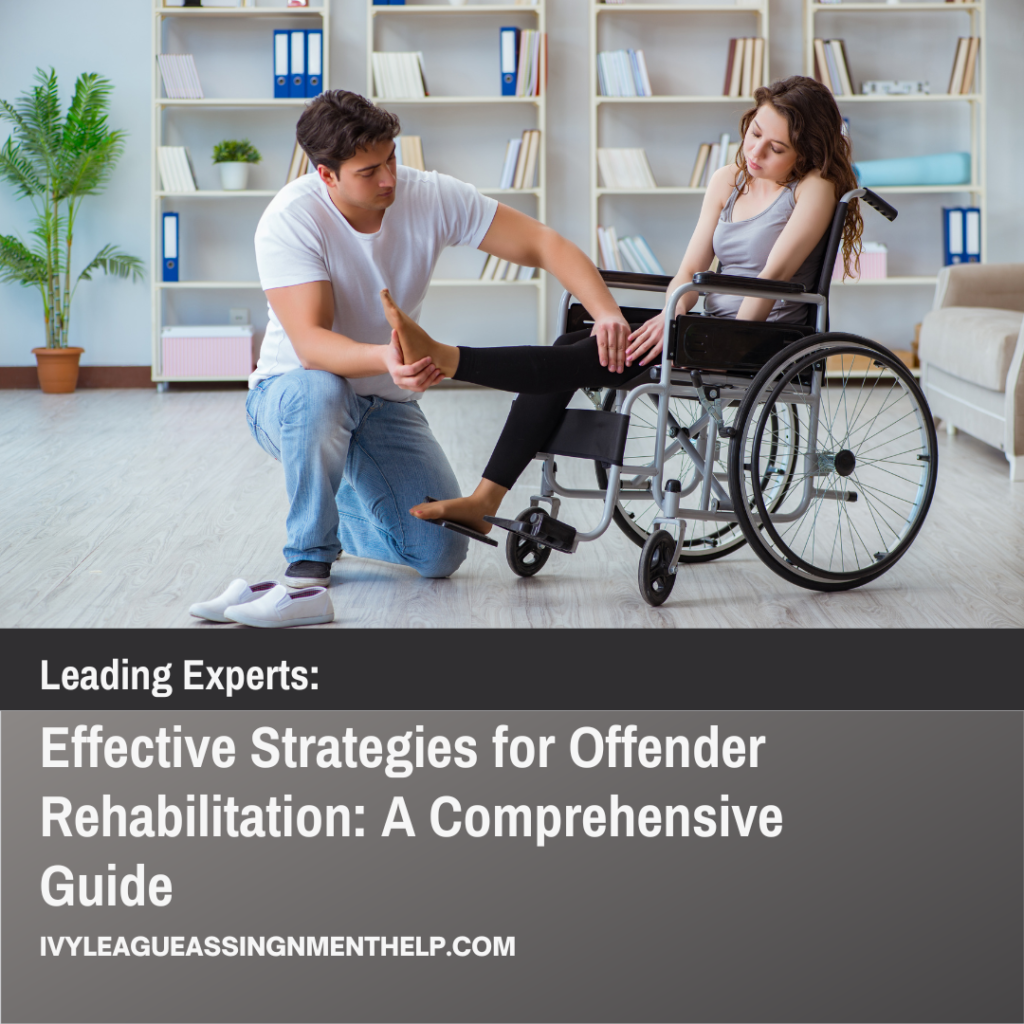Effective Strategies for Offender Rehabilitation: A Comprehensive Guide
Introduction
Offender rehabilitation aims to reform and reintegrate individuals who have committed crimes, focusing on reducing recidivism and promoting societal safety. At ivyleagueassignmenthelp.com we help and guide students to cover various aspects of offender rehabilitation, from theoretical foundations to practical applications.
What is Offender Rehabilitation?
Offender rehabilitation is a set of interventions and programs designed to reform and reintegrate individuals who have committed crimes. The primary objective is to reduce recidivism by addressing the underlying causes of criminal behavior and equipping offenders with skills and support for a law-abiding life.

History of Offender Rehabilitation
Early Approaches
In the early days, offender rehabilitation was often punitive, focusing on deterrence through harsh penalties. Rehabilitation efforts were minimal and typically centered around religious instruction and moral reform.
Evolution Over Time
The mid-20th century saw a shift towards more humane and scientifically-informed approaches. The introduction of psychological and sociological theories led to the development of various rehabilitative programs aimed at understanding and addressing the root causes of criminal behavior.
Modern Practices
Today, offender rehabilitation encompasses a broad range of programs, including educational, vocational, therapeutic, and restorative justice initiatives. These programs are designed to be holistic and individualized, taking into account the specific needs and circumstances of each offender.
Theories Behind Rehabilitation
Psychological Theories
Psychological theories focus on individual behavior and mental processes. Cognitive-behavioral therapy (CBT) is a common intervention used to change negative thought patterns and behaviors associated with criminal activity.
Sociological Theories
Sociological theories examine the impact of social structures and relationships on behavior. Programs based on these theories often focus on improving social skills, building healthy relationships, and community integration.
Criminological Theories
Criminological theories integrate psychological and sociological perspectives, emphasizing the importance of understanding the motives behind criminal behavior and the social context in which it occurs. These theories inform a range of rehabilitative strategies.
Types of Rehabilitation Programs
Educational Programs
Educational programs aim to provide offenders with basic literacy, numeracy skills, and higher education opportunities. These programs help individuals gain qualifications that improve their employment prospects upon release.
Vocational Training
Vocational training provides offenders with practical skills and certifications in trades such as carpentry, plumbing, and automotive repair. This training enhances employability and helps in securing stable employment post-release.
Cognitive Behavioral Therapy
CBT focuses on changing harmful behaviors through the modification of thought patterns. It is widely used to address issues like aggression, substance abuse, and antisocial behavior.
Substance Abuse Programs
Substance abuse programs offer treatment and support for offenders struggling with addiction. These programs combine medical treatment with counseling and peer support to promote recovery.
Mental Health Services
Mental health services address psychological disorders that may contribute to criminal behavior. Access to psychiatrists, psychologists, and therapeutic interventions are crucial for offenders with mental health issues.
Community Service and Restorative Justice
Community service and restorative justice programs focus on repairing the harm caused by criminal behavior. Offenders participate in activities that benefit the community and engage in dialogues with victims to foster understanding and accountability.
Process of Offender Rehabilitation
Assessment and Diagnosis
The rehabilitation process begins with a thorough assessment of the offender’s needs, risks, and strengths. This includes psychological evaluations, substance abuse screenings, and educational assessments.
Individualized Treatment Plans
Based on the assessment, an individualized treatment plan is developed. This plan outlines specific goals, interventions, and support services tailored to the offender’s needs.
Program Implementation
The implementation phase involves enrolling the offender in appropriate programs and providing ongoing support. This may include educational classes, therapy sessions, and vocational training.
Monitoring and Evaluation
Continuous monitoring and evaluation ensure that the rehabilitation plan is effective. Progress is tracked, and adjustments are made as needed to address any emerging issues or challenges.
Challenges in Offender Rehabilitation
Resistance from Offenders
Resistance from offenders can hinder the rehabilitation process. Building trust and motivation through counseling and positive reinforcement is crucial for overcoming resistance.
Funding and Resources
Adequate funding and resources are essential for the successful implementation of rehabilitation programs. Budget constraints can limit the availability and quality of these services.
Social Stigma
Social stigma against ex-offenders can impede their reintegration into society. Public education and community support programs are necessary to reduce stigma and promote acceptance.
Policy and Legislation
Policies and legislation play a significant role in shaping rehabilitation efforts. Advocacy for policy reforms that support rehabilitative rather than punitive approaches is ongoing.
Success Stories and Case Studies
Notable Rehabilitation Programs
Programs like the Norwegian prison system, which emphasizes humane treatment and rehabilitation, have shown remarkable success in reducing recidivism rates.
Individual Success Stories
There are numerous individual success stories where former offenders have turned their lives around through education, therapy, and vocational training.
Comparative Studies
Comparative studies of different rehabilitation programs provide valuable insights into best practices and effective strategies for reducing recidivism.
Impact of Rehabilitation on Recidivism
Statistical Evidence
Statistical evidence shows that effective rehabilitation programs significantly reduce recidivism rates. Studies indicate that education and vocational training are particularly impactful.
Long-term Outcomes
Long-term outcomes of successful rehabilitation include improved employment rates, stable housing, and reduced reliance on social services, leading to overall societal benefits.
Offender Rehabilitation in Different Countries
United States
The United States has a diverse range of rehabilitation programs, with varying levels of success. Recent reforms aim to improve these programs and reduce mass incarceration.
United Kingdom
The UK emphasizes community-based rehabilitation programs and restorative justice initiatives, focusing on reintegration and reducing reoffending.
Scandinavian Countries
Scandinavian countries like Norway and Sweden are known for their progressive rehabilitation systems that prioritize humane treatment and education, resulting in low recidivism rates.
Developing Nations
Developing nations face unique challenges in implementing rehabilitation programs due to limited resources and infrastructure. International support and local innovation are critical for progress.
Role of Technology in Rehabilitation
Digital Learning Platforms
Digital learning platforms provide educational opportunities for offenders, making it easier to access courses and gain qualifications while incarcerated.
Telehealth Services
Telehealth services offer remote access to mental health professionals, ensuring that offenders receive consistent and timely care.
Monitoring and Reporting Tools
Technological tools for monitoring and reporting help track progress and ensure compliance with rehabilitation programs, enhancing accountability.
Ethical Considerations in Rehabilitation
Informed Consent
Informed consent is essential for ethical rehabilitation. Offenders must be fully aware of the programs they are participating in and the potential outcomes.
Confidentiality
Maintaining confidentiality is crucial to protect the privacy and dignity of offenders. This includes safeguarding personal information and therapy records.
Balancing Public Safety and Individual Rights
Rehabilitation efforts must balance public safety with respecting the rights of offenders. This involves careful risk assessment and management.
Training and Education for Professionals
Qualifications and Skills Required
Professionals in the field need a combination of qualifications in psychology, criminology, and social work, along with practical skills in counseling and case management.
Professional Development
Ongoing professional development ensures that practitioners stay updated on the latest research and best practices in rehabilitation.
Best Practices
Best practices include evidence-based approaches, interdisciplinary collaboration, and a focus on individualized care and support.
Future of Offender Rehabilitation
Innovations and Emerging Trends
Emerging trends in rehabilitation include the use of artificial intelligence to personalize treatment plans and predictive analytics to identify at-risk individuals.
Policy Reforms
Policy reforms aim to shift the focus from punitive measures to rehabilitative approaches, advocating for systemic changes that support offender reintegration.
Integrating New Technologies
Integrating new technologies, such as virtual reality for therapy and advanced data analytics, promises to enhance the effectiveness of rehabilitation programs.
Offender Rehabilitation FAQs
What is offender rehabilitation?
Offender rehabilitation involves various programs and interventions aimed at reforming and reintegrating individuals who have committed crimes.
How effective is offender rehabilitation?
When properly implemented, rehabilitation programs can significantly reduce recidivism rates and improve long-term outcomes for offenders.
What types of rehabilitation programs are available?
Programs include educational and vocational training, cognitive behavioral therapy, substance abuse treatment, mental health services, and restorative justice initiatives.
What are the challenges in offender rehabilitation?
Challenges include resistance from offenders, limited funding and resources, social stigma, and policy and legislative barriers.
How does rehabilitation impact recidivism?
Effective rehabilitation programs reduce recidivism by addressing the underlying causes of criminal behavior and equipping offenders with skills and support for a law-abiding life.
What role does technology play in rehabilitation?
Technology enhances rehabilitation through digital learning platforms, telehealth services, and monitoring tools, providing more accessible and effective support.
Conclusion
Summary of Key Points
Offender rehabilitation is a vital component of the criminal justice system, aiming to reform individuals and reduce recidivism through a range of evidence-based programs.
Final Thoughts
Continued innovation, adequate funding, and supportive policies are essential for the success of rehabilitation efforts. By addressing the underlying causes of criminal behavior and providing the necessary support, society can achieve safer communities and better outcomes for offenders.
